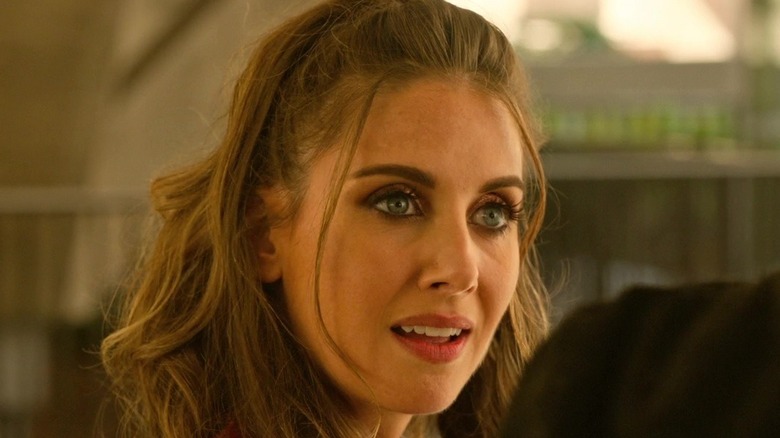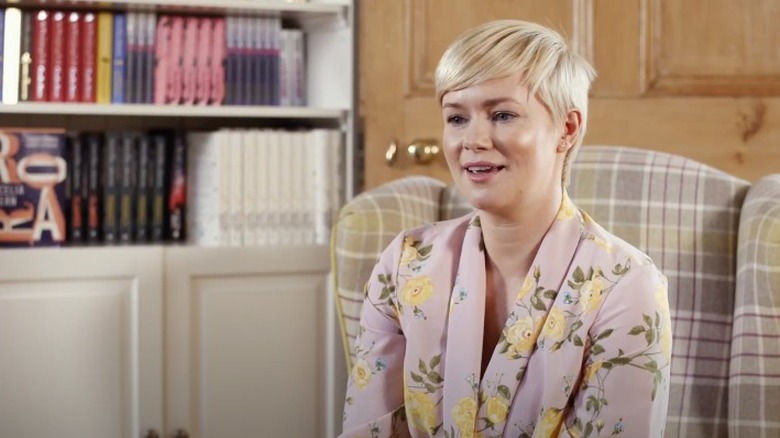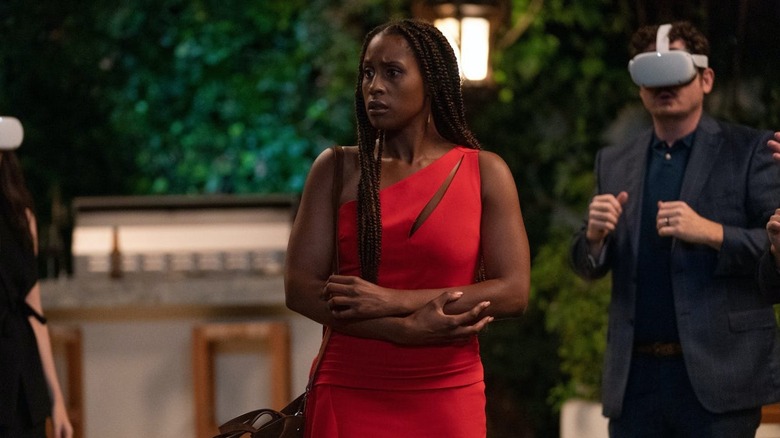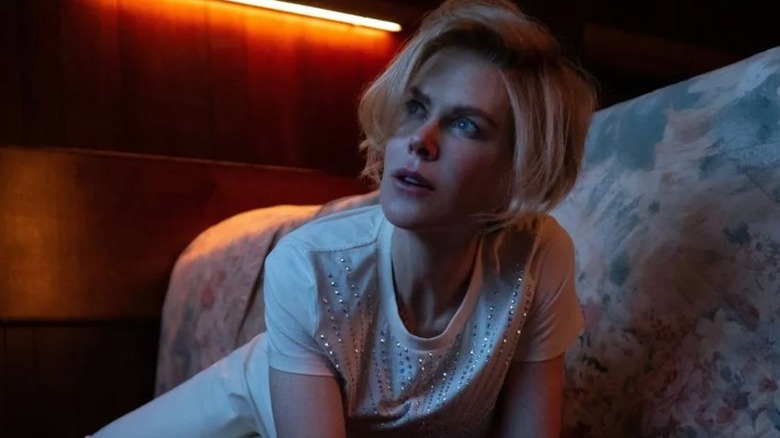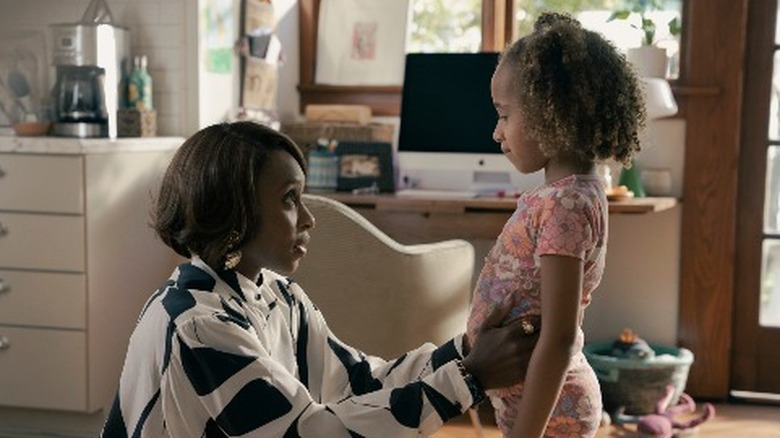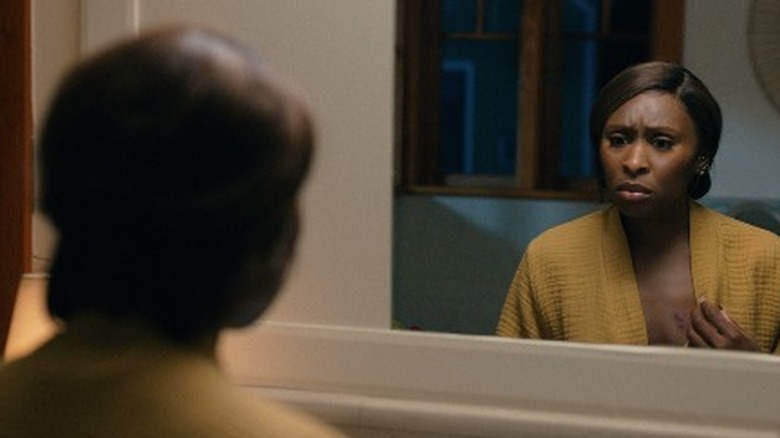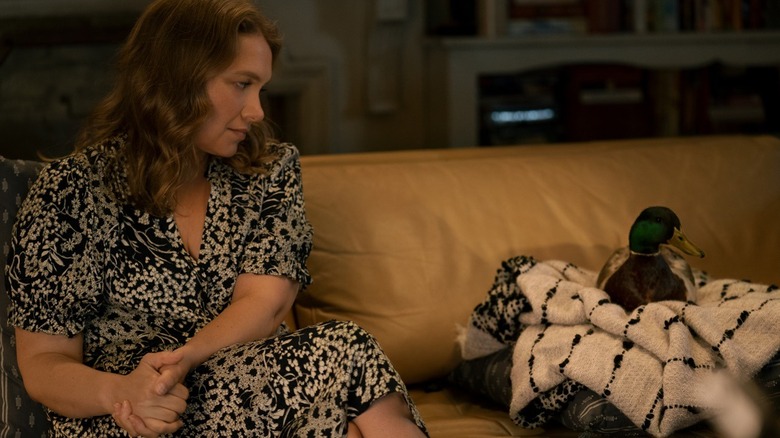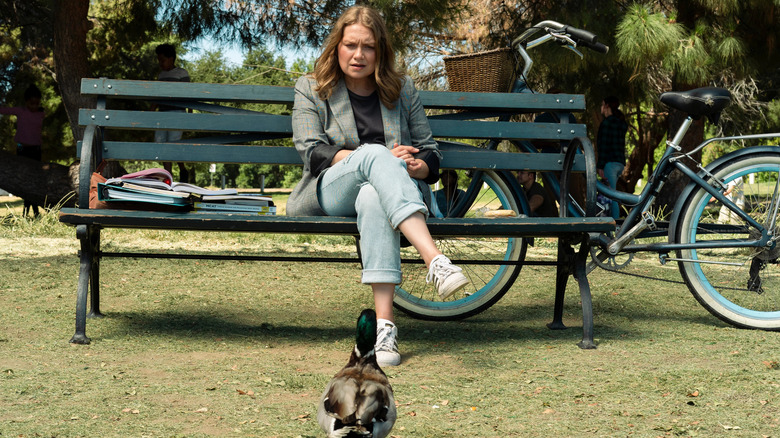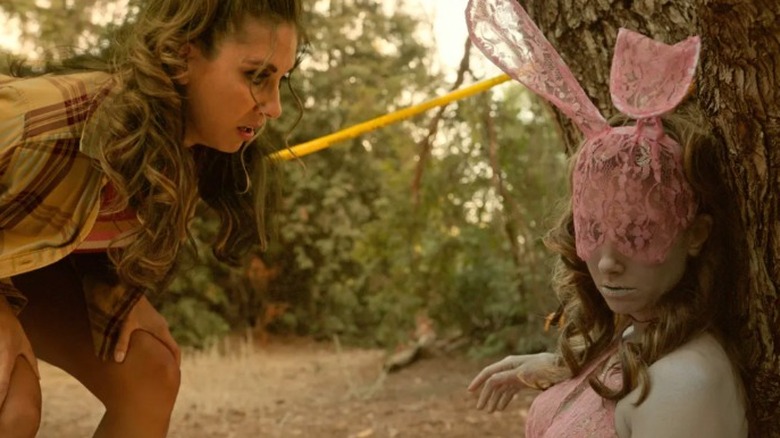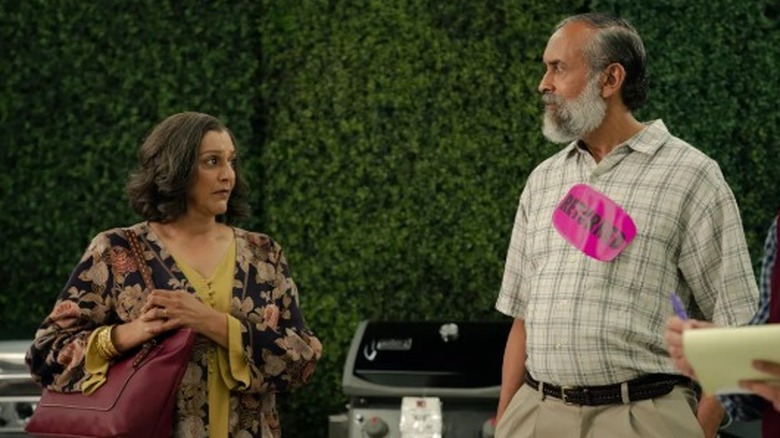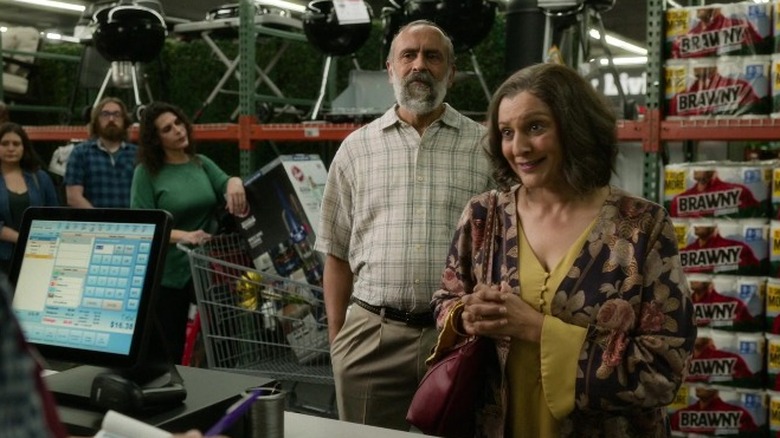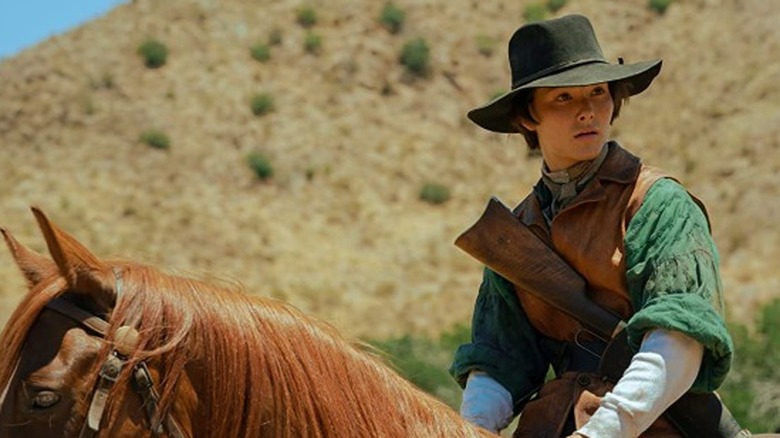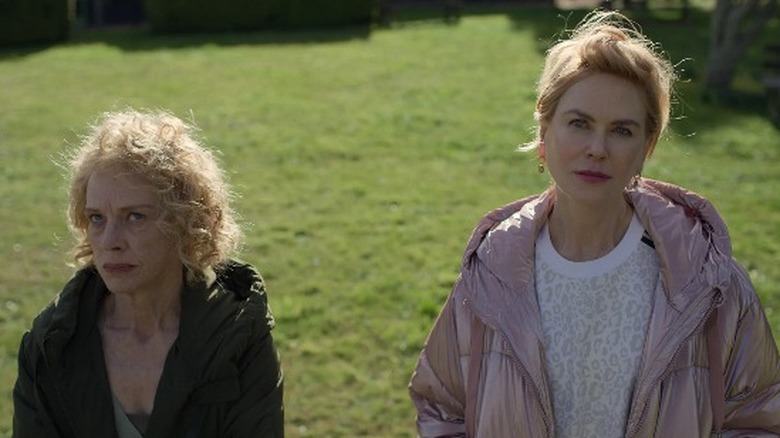The Untold Truth Of Apple TV+'s Roar
Apple TV+ is home to many different series, including "Ted Lasso," "Severance," and "The Morning Show," but one that has particularly shocked fans is "Roar." This anthology show follows eight different stories — about women, told by women, and created by women — and rivals "Black Mirror" in its darkly realistic messaging through fantastical storylines and imagery, and the way each episode genre-bends to engage the audience.
Each of the eight episodes of "Roar" stars different illustrious actors, including Issa Rae, Nicole Kidman, Betty Gilpin, Cynthia Erivo, Merritt Wever, Alison Brie, Meera Syal, Fivel Stewart, and Kara Hayward. Every episode follows a different story of a woman or women dealing with the realities of gender identity, sexuality, and feminism in general. Though the show can sometimes be fantastical, it isn't difficult to understand the deeper messaging about coping and embracing what it means to be a woman.
The show was created by Liz Flahive and Carly Mensch and executive produced by Nicole Kidman. The mission and artistry are clear, but there are some hidden details about this Apple TV+ series that some people might not know. Read on for the untold truth of "Roar."
It's based on a book
Though "Roar" was created by Liz Flahive and Caly Mensch for Apple TV+, it was based on the original source material, a 2018 collection of stories by the same name, authored by Cecilia Ahern. The mission of the book is the same as the show: to depict women overcoming adversity using the blend of personality traits they are equipped with. It's meant to be a relatable work for women to read and know they're not alone in struggles with love, identity, and life. As the website for Ahern's "Roar" says, "As they wrestle with obstacles of all kinds, their reality is shaped by how others perceive them — and ultimately, how they perceive the power within themselves."
Ahern's other works include "PS, I Love You," which was adapted into a film starring Gerard Butler and Hilary Swank, and "Where Rainbows End," which was adapted into a film called "Love, Rosie" starring Sam Claflin and Lily Collins. Clearly, she's no stranger to her work being adapted for the screen; in fact, she also has television co-creator and producing credits with shows such as "Samantha Who?" The original "Roar" book includes 30 different stories; given that the first season of the Apple TV+ production only adapted eight of them, there's plenty of room for future installments.
Issa Rae's episode was different in the book
"The Woman Who Disappeared" starts the series off strong. Starring Issa Rae, the episode follows a woman named Wanda (Rae), a writer who heads to Los Angeles to potentially option her bestselling autobiography. It's meant to show how people of color — particularly women of color — navigate a society designed for white people. This is clear from the beginning as her rental is canceled because her hairstyle changed and they don't recognize her, and the camera doesn't pick up her face enough for her credentials. She meets with problematic men who change her vision of the screen adaptation for the book to a virtual reality experience instead. The men don't acknowledge her concerns at all.
In an interview with Showbiz Cheat Sheet, Creator Liz Flahive says, "In the book, the story is actually about aging. If you look at the short story in the book, 'The Woman Who Disappeared' is about an aging academic who's becoming invisible to society." For the show, Flahive said they adapted the story to take a stance on the commodification of Black art and Black culture in light of the Black Lives Matter movement. It shows how companies and executives who wanted to "make an effort" to elevate Black voices and stories don't actually want to listen to Black people; in the process, they fall back on performative activism that can do more harm than good.
Nicole Kidman ate rice paper for her episode
The second episode of "Roar," called "The Woman Who Ate Photographs," stars Nicole Kidman as Robin, a woman preparing to move her mother in with her family in order to help care for her worsening dementia. As they fill up the moving truck and do something that every parent and child finds difficult to grapple with, Robin finds herself reminiscing about the past and trying to find a way to hold onto it. This results in her eating her family photographs from her mom's scrapbooks, which puts her right back into the place she was when they were taken. The episode is a heartbreaking tale of preserving memories, and the burdens we carry while watching time slip away.
This is represented through the shocking and almost comical sight of Kidman literally shoving photographs in her mouth during half of the episode. They wanted it to look realistic, so the creative team experimented with what would look the best without posing a health and safety hazard. In an interview with IndieWire, Creator Liz Flahive said two versions worked best: rice paper and marzipan, both of which had photographs printed on them in a way that was safe for Kidman to ingest. "I think when she was gobbling many, the rice paper ended up being better, but also it was more brittle," recalled Flahive. "Neither was perfect, but between the two, we got what we needed overall."
The Woman on the Shelf was almost about Melania Trump
The third episode in the series, called "The Woman on the Shelf," took some intense brainstorming to get just right. The episode stars Betty Gilpin and follows a model who falls in love with a rich businessman. After they move in together and get married, he builds her a shelf in his office and tells her he wants her to quit her job and sit on that shelf day in and day out while he works so he can admire her. He is initially enthralled with her, doting on her every need and constantly admiring her. However, after a while, she loses her appeal and he starts leaving her there alone. The episode is meant to act as commentary on so-called trophy wives, while highlighting the struggles they face without being cruel or unfair.
In an interview with the Los Angeles Times, Creators Liz Flahive and Carly Mensch talked about how hard it was to write that episode in particular — it went through 40 rewrites before they had a version they were truly happy with. Mensch said, "It was a visual from the book that really stuck with us and that we loved that felt like an amazing cinematic dare," said Mensch. "But we couldn't figure out the best way to honor the metaphor without denigrating trophy wives." Mensch also said there was a brief period of time when they considered making the episode about Melania Trump.
Cynthia Erivo drew experience from her mother
The fourth episode of "Roar" stars Cynthia Erivo as "The Woman Who Found Bite Marks on Her Skin." The horror-infused story follows a woman named Ambia, a mother who keeps finding bite marks on her skin that start off as baby bites and become more grotesque throughout. The episode is meant to show the difficulties that come with motherhood, but particularly losing yourself to the identity of being a mother. It portrays the difficulties of balancing relationships and careers with being a mother, and the guilt that comes with doing anything for yourself and not for your child.
In her interview with E! News, Erivo said people forget that "mothers are still human beings" and talked about how mothers need space to live their own lives separately from their children without fear or guilt. Erivo was raised by a single mother, and used that experience with her mom's strength to inform this performance. Erivo's hindsight gave her the perspective she needed, as she is not a mother herself but watched her mother experience certain hardships in motherhood. "I think sometimes we are very hard on women who want to have a very successful work life," she pointed out. "We sometimes make them have to sacrifice one for the other, but I don't believe that you do have to do that. I think you can be a mother and you can be really successful as a businessperson."
The bite marks were heavily planned out in Episode 4
In "Roar" Episode 4, "The Woman Who Found Bite Marks on Her Skin," Cynthia Erivo's character, Ambia suddenly finds bite marks on her skin. At first they look human, but as the episode progresses, the bites become more intense and develop a less man-made appearance. The episode is meant to showcase maternal guilt, and how when a woman has a child, she starts to lose her identity as a woman and is mostly seen as a mother.
Creators Liz Flahive and Carly Mensch knew they wanted to handle the bite marks practically, only receiving help from special effects editing with some of the oozing and blood. They used makeup artist Lana Horochowski to create the bites on Erivo and worked with director Rashida Jones and Erivo on where they should be placed, their progression, and more. Flahive described it for IndieWire as being a "vine of bite-mark guilt wrapping around her," starting from her breast, moving around her body, and working its way up to her face. They wanted the bite marks to tell a story; as Flahive said, "As her guilt progresses, it should get more out of control. The less she talks about it, the more she represses her feelings of guilt, the more aggressive the bite marks become. And it's not until she actually talks about it fully, that they recede."
They almost axed that duck scene
The fifth episode of "Roar" is slightly controversial, as it involves a woman falling in love with a duck. "The Woman Who Was Fed by a Duck" stars Merritt Wever as Elisa, who struggles with dating in her thirties. She meets Larry, who seems like a partner that's too good to be true, only he's a duck. Not only that, but Larry is actually a representation of yet another type of abusive male partner — one who is insecure and represses women through passive aggression. The episode tries to portray what it's like to find and lose yourself through the lens of a relationship.
One scene in particular got people talking, and given that it involves sex between Elisa and Larry, it isn't hard to understand why. Per Flahive in an interview with Glamour, the Apple TV+ executives were a bit nervous as to how the scene would go over with audiences, and were hesitant to keep it in the episode. As it turns out, executive producer Nicole Kidman pushed for the scene to stay — and for Flahive and the other creators not to back down. As Flahive summed it up, "When you have a really big movie star (executive producer) championing an episode about a woman getting into a toxic relationship with a duck very loudly on a phone call, it's really helpful!"
The duck romance was treated like any other
In "The Woman Who Was Fed by a Duck," there's an intense romance between Elisa (Merritt Wever) and a duck named Larry (voiced by Justin Kirk). The episode shows Elisa and Larry in full-fledged flirtation, violent arguments, and even a legitimate sex scene. The whole episode is meant to showcase how women can lose themselves and struggle to keep their own identities within the confines of a relationship. Elisa is found being isolated from her support system by Larry, and struggles to figure out who she is with him constantly in her ear, making judgments about her life.
Though this episode features an interspecies romance, it was treated the same as every other television relationship. Per Creator Liz Flahive's interview with IndieWire, there was a lot to go over with this, particularly the sex scene. First off, the creators used a real duck — they wanted the authenticity of using an animal instead of a CGI creation. Second, though Kirk did the voice, they wanted him on set every day doing the voice off camera for the scenes instead of just dubbing his lines in a studio. Finally, just as with many other sex scenes is treated, there was a closed set and an intimacy coordinator. "You're taking some weird swings and I feel like it was nice to be scared," said Flahive. "It was nice to feel like we were doing something that hadn't necessarily happened a bunch of times before."
Alison Brie felt like she was truly her character
"Roar" takes a detour into the crime genre with Episode 6, "The Woman Who Solved Her Own Murder." Starring Alison Brie, the episode follows Rebecca, a woman who has just been murdered and comes back as a ghost. She tags along with the detectives trying to solve her murder as she conducts her own investigation, wracking her brain to deduct who could've killed her. The episode shows the violence women face from men on a daily basis, and how women can often be dismissed and blamed for this violence instead of the men who actually did it.
For Brie, this episode was a challenge. In an interview with Collider, she said the role tested her self-confidence because she was playing a ghost — she wasn't able to interact with anyone, so it all had to come from within. "If anything, it really connected me more to the character because I was experiencing it," she explained. "In trying to perform this character, I was going through what she is going through as a character, which is obviously not being seen or heard, and having to take things into her own hands."
Brie went on to describe how surreal the set experience was, because it was the first time she couldn't experience any chemistry with her co-stars; she also praised the other actors for their performances, particularly their ability to not react while she screamed in their faces.
Meera Syal didn't audition for her role
Episode 7 of "Roar" is one that lots of married women might relate to. It stars Meera Syal as Anu, a woman who discovers her husband's warranty and decides to return him to the store because of his behavior. He's no longer the husband she married, and she's frustrated — but when she takes him to be returned, the store says she can only exchange him for another husband. She tries out many husbands, but eventually ends up back with Vikras. The episode is meant to show that marriage takes work, and that both parties must pull their weight for it to succeed.
Syal's performance is excellent, and the creators knew from the beginning she was the right person for the role. In an interview with AV Club, Syal said she didn't even have to audition — that's how sure they were about casting her. "My agent shared the incredible script with me and I thought I'd have to do loads of auditions," she recalled. "But I had a chat with Liz, Carly, and Vera Santamaria, the writer of my episode. By the end of the conversation, they asked me to do it." Syal said Santamaria had a clear vision of Anu and who she wanted her to be; she based Anu on her mother, who is also South Asian but grew up in Britain.
They shot on location at Costco
In "The Woman Who Returned Her Husband," Anu (Meera Syal) exchanges her husband Vikras (Bernard White) for another, but eventually realizes she wants him back. Unfortunately, Vikras has already been purchased by their neighbor, so Anu has to steal him back. After it's all over, they both agree to put more effort in with each other to make the marriage work.
"The Woman Who Returned Her Husband" takes place in a few different locations, one of which is the store where Anu attempts to return Vikras. For this, per an interview with AV Club, Syal said they actually filmed on location at a Costco, and that the store scenes were her favorite parts to shoot. Reliving the humor of seeing the husband aisle with price tags, she added, "The store we filmed at was open to customers at the time; a lot of them were sticking their heads to see what we were up to. Some women joked to say 'Can we drop off ours here?' It was nice to see the episode already feel relatable."
One episode was shot in a heat wave
The last episode of the season, "The Girl Who Loved Horses," follows Jane (Fivel Stewart), a girl obsessed with horses and riding. She's dealing with her relationship with her father, who wants to connect with her while she just wants space — but when she finds him dead in the middle of town, she becomes consumed with rage and vows to take revenge on the man who killed him. Her friend tries to stop her, but Jane feels that in order to get revenge on a man she has to act like one, so she heads into the wilderness after the killer with her friend by her side.
According to co-creators Liz Flahive and Carly Mensch, "The Girl Who Loved Horses" was particularly difficult to shoot. Though they admitted that like any filmmakers, they had struggles with every episode, Flahive and Mensch told the Los Angeles Times that this one ended up being tough because it was filmed during an extreme heat wave. Describing the temperatures as "like 100-something degrees," Mensch expressed empathy for "these poor teenagers ... in leather and period garb." They praised everyone's hard work, especially given the added layer of difficulty of filming during the COVID-19 pandemic.
There may be another season
"Roar" is, for now, regarded as a limited series, which means there's no telling whether there will be a second season — but in an interview with the Los Angeles Times, co-creator Carly Mensch said she hopes audiences are so satisfied with the stories they've seen so far that they want to hear more. Fellow co-creator Liz Flahive added, "There are a lot of other stories under this umbrella that we could tell and a lot of other writer-directors we could work with."
Speaking with Coup De Main Magazine, executive producer Nicole Kidman said she'd love to make an eight-episode follow-up season. "I would love that we would get the chance to tell eight more of them," she mused, "because they're just so delicious, and hopefully there's a deliciousness to watching them." Kidman said she loves that there are different genres and stories for everyone, and that people can watch them in the order they want — or just the selection they want. Here's hoping those wishes come true.
